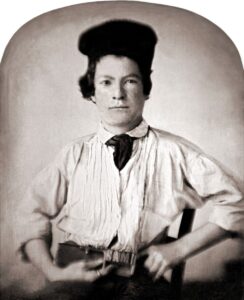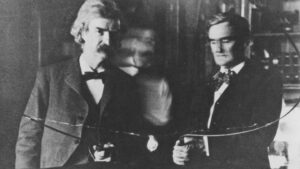BIOGRAPHY:

The famous writer Mark Twain (real name Samuel Langhorne Clemens) was born on November 30, 1835 in an American large family. His parents were John and Jane Clemens, natives of Missouri. Samuel was the sixth child; besides him, there were four more boys and two girls in the family.
But not all children were able to survive the difficult years; three of them died at an early age. When Sam was four years old, the Clemens family moved to the city of Hannibal in search of a better life. Later, this city with its funny inhabitants and Samuel’s funny adventures in it will be reflected in the famous work of the writer “The Adventures of Tom Sawyer”.
From a young age, Mark Twain was attracted to the water element; he could sit on the river bank for a long time and look at the waves; he even drowned several times, but was safely rescued. He was especially interested in steamships; Sam dreamed that when he grew up, he would become a sailor and sail on his own ship. It was thanks to this passion that the writer’s pseudonym was chosen – mark twain, which translated means “deep water”, literally “measure two”.
In Hannibal, Samuel met Tom Blankenship, the son of an old tramp and alcoholic living in a hut near the river. They became best friends, and over time a whole company of the same adventure lovers gathered. Tom became the prototype for Huckleberry Finn, the main character of many of the author’s popular children’s books.
When Sam was 12 years old, his father died suddenly of pneumonia. Shortly before his death, John Clemens took on the debts of a close friend, but was never able to pay them off in full. Samuel was forced to look for work to help his family. His older brother Orion got him a job as a typesetter at a local newspaper printing house. Sam tried to publish his own poems and articles in the newspaper, but at first this only irritated Orion. In addition to the local press, the young writer sent his first works to other editorial offices, where they were willingly published.
Youth and early career:

In 1857, Mark Twain became a pilot’s apprentice, and two years later received his own license to drive a ship. However, due to the civil war that broke out in 1861, he was forced to leave his favorite business and look for a new job. In the same year, Mark Twain travels with his brother Orion west to Nevada. There he worked for almost a year in the silver mines in a mining town, hoping to get rich, but luck was not on his side.
In 1862, Twain got a job at the editorial office of a local newspaper, where he used his creative pseudonym for the first time. A few years later, his works and articles were published in several publications. In 1865, Mark Twain gained fame; his humoresque “The Famous Jumping Frog of Calaveras” became popular throughout America, and many publishers published it several times.
The first book and the creation of a family:

At the height of his writing career, Mark Twain traveled a lot, visited England, Australia, Africa and even Odessa, and traveled all over Europe. During these travels, he sent letters to his hometown, which were then published in the newspaper. Later, these letters will become the basis for the book “Innocents Abroad,” which was the writer’s first serious creation. It was published in 1869 and brought Twain the great success he deserved.
At the height of his fame from the publication of his first book, Mark Twain married Olivia Langdon, the daughter of a successful entrepreneur. But first, the writer had to try hard to win over Olivia’s parents. In 1870 they became engaged. Mark Twain loved his wife madly and considered her a perfect and ideal woman, took care of her and never criticized her. Olivia considered him an eternal boy who would never grow up. Over 30 years of marriage, they had four children.
In 1871, Mark Twain and his wife moved to Hartford, where he spent the calmest and happiest years of his life. In this city, he founded his own publishing company, which began to generate good income. During these years, Mark Twain himself became interested in satire, writing long stories ridiculing the vices of American society.
The blossoming of a creative career:

The idea of creating an autobiographical novel had been brewing for a long time, and after several unsuccessful attempts, in two years with short breaks, Mark Twain created “The Adventures of Tom Sawyer.” The novel is based on the author’s childhood memories. But the writer’s most significant contribution to literature is the novel “The Adventures of Huckleberry Finn.” Some critics call this work the pinnacle of American literary art, the characters in the novel were so vividly and vividly described.
All his life, Mark Twain was interested in the Middle Ages; he was concerned about some of the issues and problems of those years. In 1882, the writer’s story “The Prince and the Pauper” was published, in which Twain, with great enthusiasm and aplomb, denies the world of social inequality. And in 1889, another historical novel, “A Yankee in the Court of King Arthur,” was published, on every page of which there was enough sharp irony and satire.
Mark Twain was personally acquainted with Nikola Tesla; his lively mind was interested in the scientific achievements of our time. They often conducted experiments and experiments in Tesla’s laboratory. Some technical details in his novels, for example, about time travel, appeared precisely thanks to close communication with Nikola Tesla.
The writer’s contemporaries also noted his addiction to pipe smoking. According to many, there was often such thick tobacco smoke in Twain’s office that it was like a fog, it was impossible to see anything in it.
Death of his wife and later years of the writer:

In 1904, Olivia, Twain’s beloved wife, died suddenly. Even in her youth, having fallen unsuccessfully on ice, she became disabled, and with age her condition only worsened. The writer experienced the loss of his wife very hard, his physical and mental health deteriorated. He didn’t want to live without his beloved Olivia. After the death of his wife, Mark Twain completely stopped communicating with the female sex, although there were contenders for his heart, he remained faithful to his wife. In addition, three of his children tragically died. All these sad events led to the writer becoming severely depressed. The works published at the end of his life were slightly different in genre from the previous ones; poisonous irony and even sarcasm or, conversely, bitterness and fatigue were noticeable in them. Mark Twain’s financial situation also worsened – his publishing company, in which he had invested most of his funds, collapsed.
Some of the writer’s works never saw the light of day; many manuscripts were rejected due to their harsh content. For example, Twain loved to write all sorts of essays and poems with an erotic slant, but such creations were distributed only in a narrow circle of close people. The most famous work in this genre is the essay “1601: Fireside Chats,” which is about the English queen herself and her subjects.
The end of life’s journey:

Mark Twain passed away in April 1910, dying of angina. Shortly before his death, he predicted to himself that he had a year to live.
In the city of Hannibal, the house in which little Samuel grew up, those caves that he carefully explored with his friends, are still preserved; these places have become popular for tourists in the city. The house in which he lived for 20 years in Hartford is now the Mark Twain Museum, and is named a national treasure in American history.
Writer’s friends:

Samuel Clemens treasured his friendship with Nikola Tesla. The age difference of more than 20 years did not interfere with their creative communication. Together they participated in the physicist’s bold experiments, and in his free time the writer often made fun of his serious friend. But one day Nikola still managed to laugh it off. He offered the aged Samuel a certain means of rejuvenation, and after happily trying it, the writer felt that he was getting younger before his eyes. But after a while he rushed to the restroom due to severe stomach pain. According to him, the remedy had a radical cleansing effect on him. In 1893, fate brought Mark Twain together with financial magnate Henry Rogers, who was known as a great misanthrope and miser. But close friendship with the writer changed him. The banker not only helped the writer’s family overcome financial difficulties, but also became a real donor and philanthropist, which became evident after his death. Henry spent a lot of money supporting young talent. He also organized jobs for people with disabilities.
Quotes:
Samuel Clemens was a very sharp-tongued man. This was manifested both in his writing and in his spoken speech. Many of his statements became catchphrases that have not lost their relevance to this day. Here are some of them:
- “Quitting smoking is easy. I threw it a hundred times myself.”
- “Be careful when reading books about health. You could die from a typo”
- “First of all, you need facts, and only then you can twist them”
Bibliography:
The Famous Jumping Frog of Calaveras – 1867
Simpletons Abroad – 1869
The Adventures of Tom Sawyer – 1876
The Prince and the Pauper – 1882
The Adventures of Huckleberry Finn -1884
A Connecticut Yankee in King Arthur’s Court -1889
American Challenger – 1892
Tom Sawyer Abroad – 1894
Dupe Wilson – 1894
Tom Sawyer – Detective – 1896
Personal memories of Joan of Arc by Sieur Louis de Comte, her page and her secretary – 1896
The Mysterious Stranger – 1916
